Business Strategy Report: Aston Martin - PESTLE, SWOT, and Five Forces
VerifiedAdded on 2021/02/20
|12
|4092
|38
Report
AI Summary
This report provides a detailed business strategy analysis of Aston Martin Global Lagonda Holding Plc. It begins with an introduction to business strategies and their impact on organizational structure, followed by an examination of Aston Martin's macro environment using a PESTLE analysis, covering political, economic, social, technological, legal, and environmental factors. The report then delves into the internal environment, applying a SWOT analysis to identify the company's strengths, weaknesses, opportunities, and threats. Furthermore, it applies Porter's Five Forces model to assess the competitive landscape and the attractiveness of the automotive industry. Finally, the report proposes strategic planning for the organization, including alternative growth strategies and a strategic plan specifically tailored for Aston Martin, culminating in a conclusion and references.
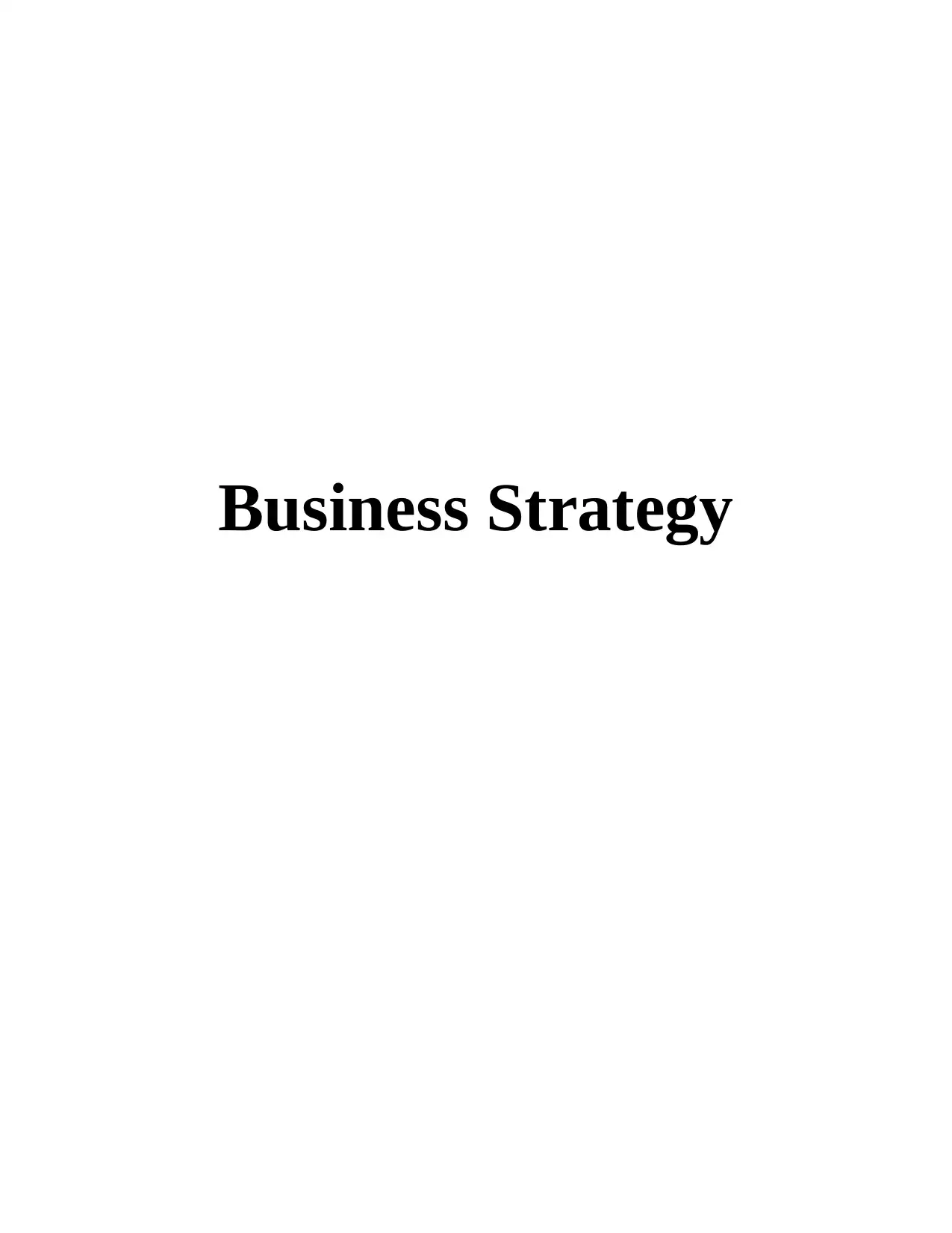
Business Strategy
Paraphrase This Document
Need a fresh take? Get an instant paraphrase of this document with our AI Paraphraser
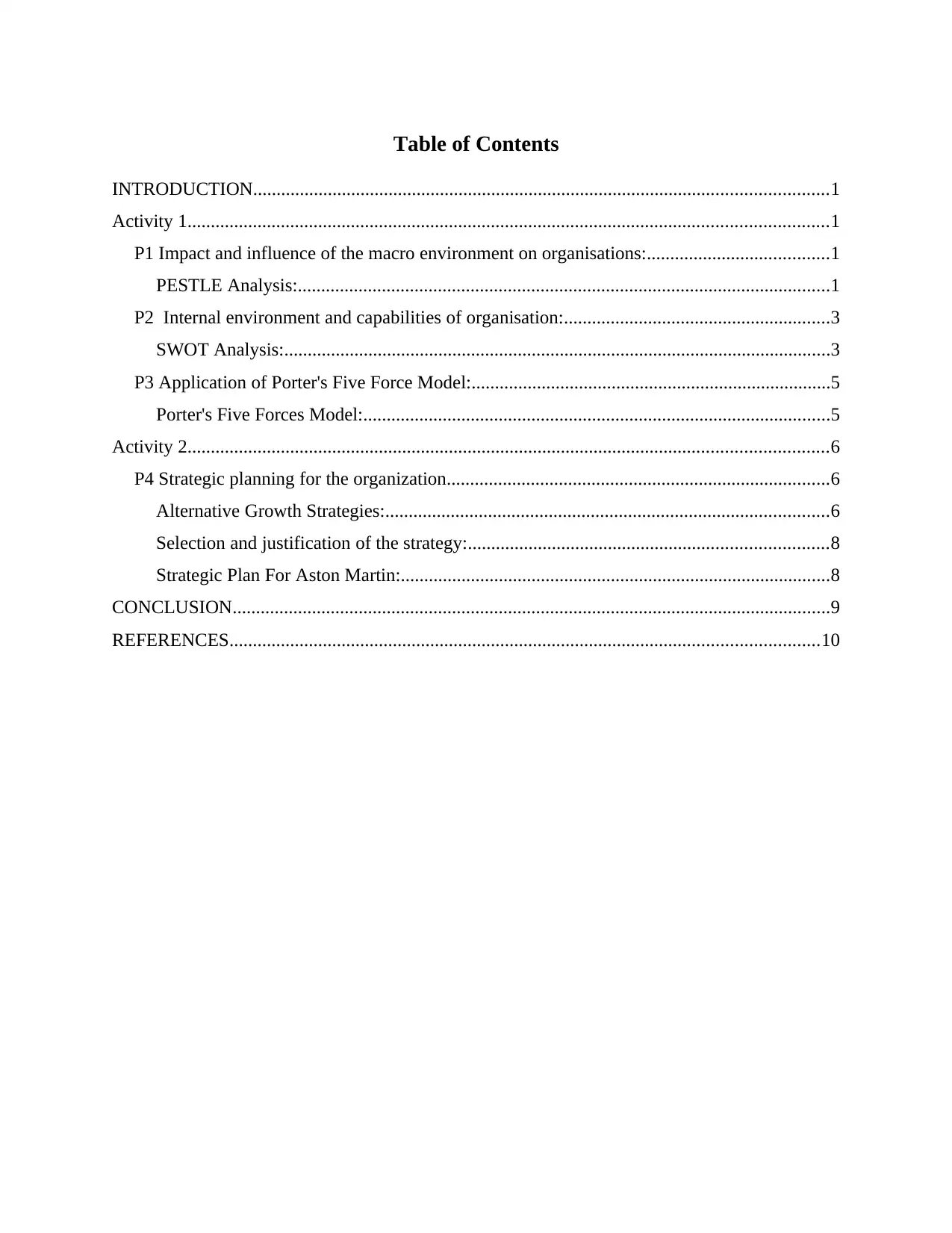
Table of Contents
INTRODUCTION...........................................................................................................................1
Activity 1.........................................................................................................................................1
P1 Impact and influence of the macro environment on organisations:.......................................1
PESTLE Analysis:..................................................................................................................1
P2 Internal environment and capabilities of organisation:.........................................................3
SWOT Analysis:.....................................................................................................................3
P3 Application of Porter's Five Force Model:.............................................................................5
Porter's Five Forces Model:....................................................................................................5
Activity 2.........................................................................................................................................6
P4 Strategic planning for the organization..................................................................................6
Alternative Growth Strategies:...............................................................................................6
Selection and justification of the strategy:.............................................................................8
Strategic Plan For Aston Martin:............................................................................................8
CONCLUSION................................................................................................................................9
REFERENCES..............................................................................................................................10
INTRODUCTION...........................................................................................................................1
Activity 1.........................................................................................................................................1
P1 Impact and influence of the macro environment on organisations:.......................................1
PESTLE Analysis:..................................................................................................................1
P2 Internal environment and capabilities of organisation:.........................................................3
SWOT Analysis:.....................................................................................................................3
P3 Application of Porter's Five Force Model:.............................................................................5
Porter's Five Forces Model:....................................................................................................5
Activity 2.........................................................................................................................................6
P4 Strategic planning for the organization..................................................................................6
Alternative Growth Strategies:...............................................................................................6
Selection and justification of the strategy:.............................................................................8
Strategic Plan For Aston Martin:............................................................................................8
CONCLUSION................................................................................................................................9
REFERENCES..............................................................................................................................10
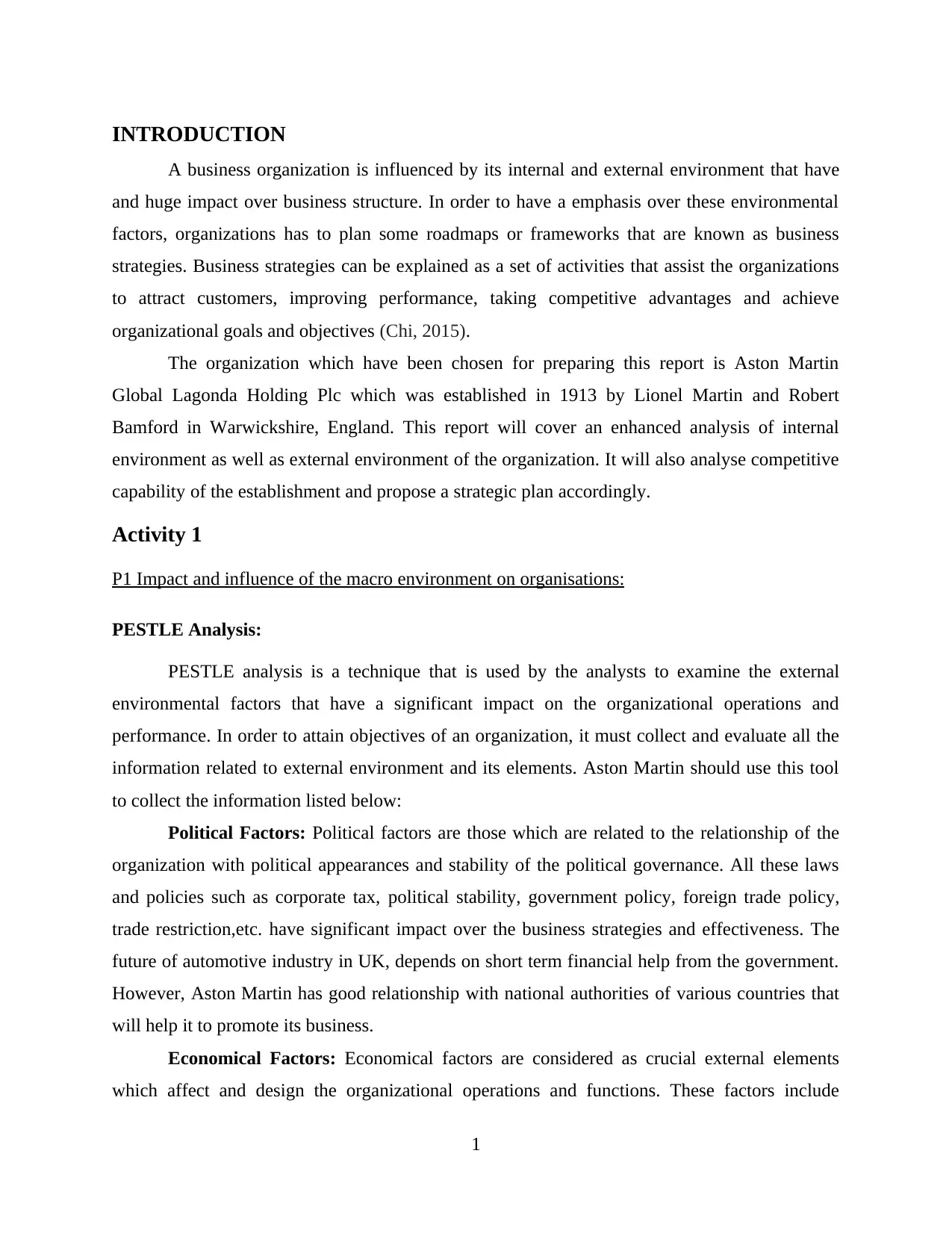
INTRODUCTION
A business organization is influenced by its internal and external environment that have
and huge impact over business structure. In order to have a emphasis over these environmental
factors, organizations has to plan some roadmaps or frameworks that are known as business
strategies. Business strategies can be explained as a set of activities that assist the organizations
to attract customers, improving performance, taking competitive advantages and achieve
organizational goals and objectives (Chi, 2015).
The organization which have been chosen for preparing this report is Aston Martin
Global Lagonda Holding Plc which was established in 1913 by Lionel Martin and Robert
Bamford in Warwickshire, England. This report will cover an enhanced analysis of internal
environment as well as external environment of the organization. It will also analyse competitive
capability of the establishment and propose a strategic plan accordingly.
Activity 1
P1 Impact and influence of the macro environment on organisations:
PESTLE Analysis:
PESTLE analysis is a technique that is used by the analysts to examine the external
environmental factors that have a significant impact on the organizational operations and
performance. In order to attain objectives of an organization, it must collect and evaluate all the
information related to external environment and its elements. Aston Martin should use this tool
to collect the information listed below:
Political Factors: Political factors are those which are related to the relationship of the
organization with political appearances and stability of the political governance. All these laws
and policies such as corporate tax, political stability, government policy, foreign trade policy,
trade restriction,etc. have significant impact over the business strategies and effectiveness. The
future of automotive industry in UK, depends on short term financial help from the government.
However, Aston Martin has good relationship with national authorities of various countries that
will help it to promote its business.
Economical Factors: Economical factors are considered as crucial external elements
which affect and design the organizational operations and functions. These factors include
1
A business organization is influenced by its internal and external environment that have
and huge impact over business structure. In order to have a emphasis over these environmental
factors, organizations has to plan some roadmaps or frameworks that are known as business
strategies. Business strategies can be explained as a set of activities that assist the organizations
to attract customers, improving performance, taking competitive advantages and achieve
organizational goals and objectives (Chi, 2015).
The organization which have been chosen for preparing this report is Aston Martin
Global Lagonda Holding Plc which was established in 1913 by Lionel Martin and Robert
Bamford in Warwickshire, England. This report will cover an enhanced analysis of internal
environment as well as external environment of the organization. It will also analyse competitive
capability of the establishment and propose a strategic plan accordingly.
Activity 1
P1 Impact and influence of the macro environment on organisations:
PESTLE Analysis:
PESTLE analysis is a technique that is used by the analysts to examine the external
environmental factors that have a significant impact on the organizational operations and
performance. In order to attain objectives of an organization, it must collect and evaluate all the
information related to external environment and its elements. Aston Martin should use this tool
to collect the information listed below:
Political Factors: Political factors are those which are related to the relationship of the
organization with political appearances and stability of the political governance. All these laws
and policies such as corporate tax, political stability, government policy, foreign trade policy,
trade restriction,etc. have significant impact over the business strategies and effectiveness. The
future of automotive industry in UK, depends on short term financial help from the government.
However, Aston Martin has good relationship with national authorities of various countries that
will help it to promote its business.
Economical Factors: Economical factors are considered as crucial external elements
which affect and design the organizational operations and functions. These factors include
1
⊘ This is a preview!⊘
Do you want full access?
Subscribe today to unlock all pages.

Trusted by 1+ million students worldwide
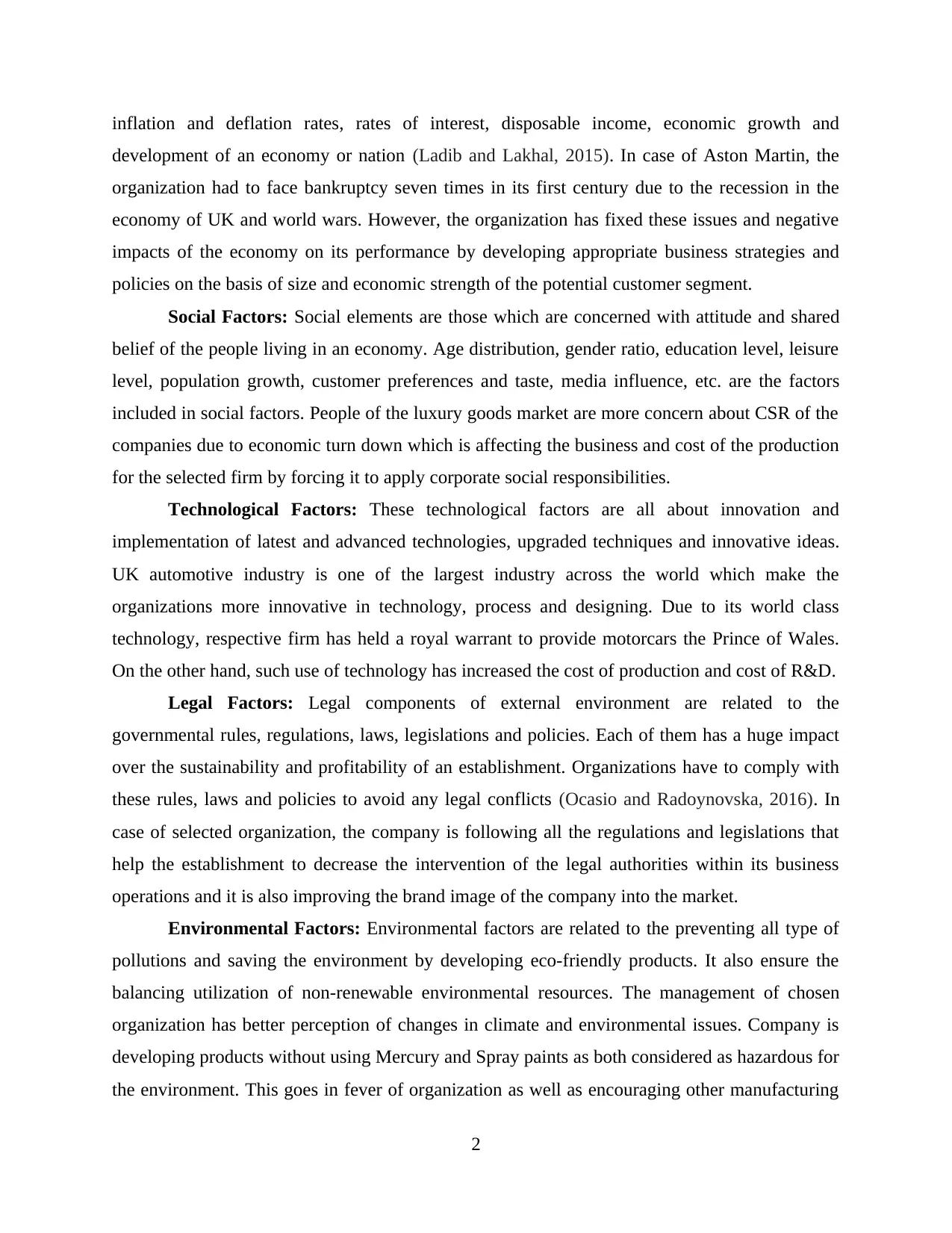
inflation and deflation rates, rates of interest, disposable income, economic growth and
development of an economy or nation (Ladib and Lakhal, 2015). In case of Aston Martin, the
organization had to face bankruptcy seven times in its first century due to the recession in the
economy of UK and world wars. However, the organization has fixed these issues and negative
impacts of the economy on its performance by developing appropriate business strategies and
policies on the basis of size and economic strength of the potential customer segment.
Social Factors: Social elements are those which are concerned with attitude and shared
belief of the people living in an economy. Age distribution, gender ratio, education level, leisure
level, population growth, customer preferences and taste, media influence, etc. are the factors
included in social factors. People of the luxury goods market are more concern about CSR of the
companies due to economic turn down which is affecting the business and cost of the production
for the selected firm by forcing it to apply corporate social responsibilities.
Technological Factors: These technological factors are all about innovation and
implementation of latest and advanced technologies, upgraded techniques and innovative ideas.
UK automotive industry is one of the largest industry across the world which make the
organizations more innovative in technology, process and designing. Due to its world class
technology, respective firm has held a royal warrant to provide motorcars the Prince of Wales.
On the other hand, such use of technology has increased the cost of production and cost of R&D.
Legal Factors: Legal components of external environment are related to the
governmental rules, regulations, laws, legislations and policies. Each of them has a huge impact
over the sustainability and profitability of an establishment. Organizations have to comply with
these rules, laws and policies to avoid any legal conflicts (Ocasio and Radoynovska, 2016). In
case of selected organization, the company is following all the regulations and legislations that
help the establishment to decrease the intervention of the legal authorities within its business
operations and it is also improving the brand image of the company into the market.
Environmental Factors: Environmental factors are related to the preventing all type of
pollutions and saving the environment by developing eco-friendly products. It also ensure the
balancing utilization of non-renewable environmental resources. The management of chosen
organization has better perception of changes in climate and environmental issues. Company is
developing products without using Mercury and Spray paints as both considered as hazardous for
the environment. This goes in fever of organization as well as encouraging other manufacturing
2
development of an economy or nation (Ladib and Lakhal, 2015). In case of Aston Martin, the
organization had to face bankruptcy seven times in its first century due to the recession in the
economy of UK and world wars. However, the organization has fixed these issues and negative
impacts of the economy on its performance by developing appropriate business strategies and
policies on the basis of size and economic strength of the potential customer segment.
Social Factors: Social elements are those which are concerned with attitude and shared
belief of the people living in an economy. Age distribution, gender ratio, education level, leisure
level, population growth, customer preferences and taste, media influence, etc. are the factors
included in social factors. People of the luxury goods market are more concern about CSR of the
companies due to economic turn down which is affecting the business and cost of the production
for the selected firm by forcing it to apply corporate social responsibilities.
Technological Factors: These technological factors are all about innovation and
implementation of latest and advanced technologies, upgraded techniques and innovative ideas.
UK automotive industry is one of the largest industry across the world which make the
organizations more innovative in technology, process and designing. Due to its world class
technology, respective firm has held a royal warrant to provide motorcars the Prince of Wales.
On the other hand, such use of technology has increased the cost of production and cost of R&D.
Legal Factors: Legal components of external environment are related to the
governmental rules, regulations, laws, legislations and policies. Each of them has a huge impact
over the sustainability and profitability of an establishment. Organizations have to comply with
these rules, laws and policies to avoid any legal conflicts (Ocasio and Radoynovska, 2016). In
case of selected organization, the company is following all the regulations and legislations that
help the establishment to decrease the intervention of the legal authorities within its business
operations and it is also improving the brand image of the company into the market.
Environmental Factors: Environmental factors are related to the preventing all type of
pollutions and saving the environment by developing eco-friendly products. It also ensure the
balancing utilization of non-renewable environmental resources. The management of chosen
organization has better perception of changes in climate and environmental issues. Company is
developing products without using Mercury and Spray paints as both considered as hazardous for
the environment. This goes in fever of organization as well as encouraging other manufacturing
2
Paraphrase This Document
Need a fresh take? Get an instant paraphrase of this document with our AI Paraphraser
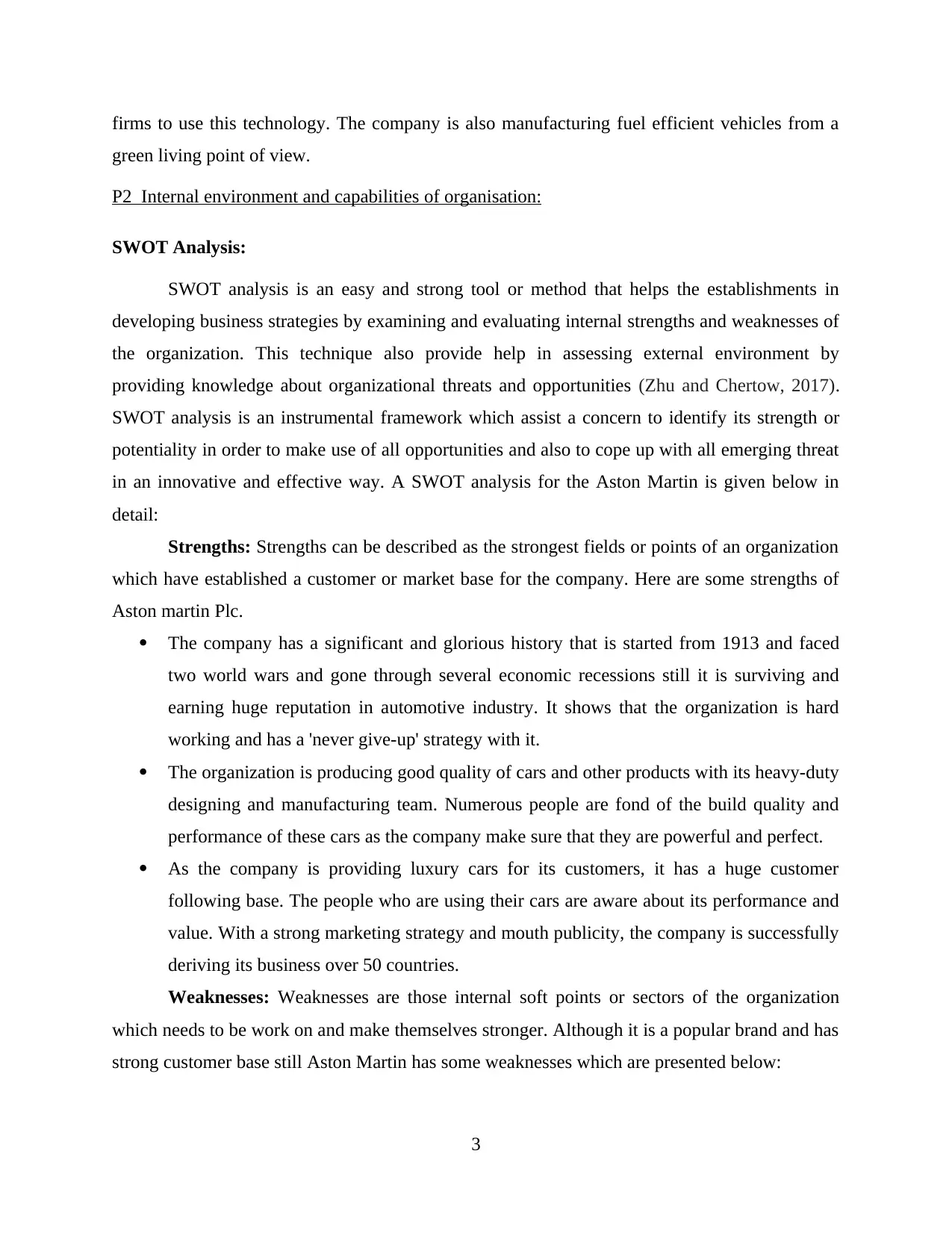
firms to use this technology. The company is also manufacturing fuel efficient vehicles from a
green living point of view.
P2 Internal environment and capabilities of organisation:
SWOT Analysis:
SWOT analysis is an easy and strong tool or method that helps the establishments in
developing business strategies by examining and evaluating internal strengths and weaknesses of
the organization. This technique also provide help in assessing external environment by
providing knowledge about organizational threats and opportunities (Zhu and Chertow, 2017).
SWOT analysis is an instrumental framework which assist a concern to identify its strength or
potentiality in order to make use of all opportunities and also to cope up with all emerging threat
in an innovative and effective way. A SWOT analysis for the Aston Martin is given below in
detail:
Strengths: Strengths can be described as the strongest fields or points of an organization
which have established a customer or market base for the company. Here are some strengths of
Aston martin Plc.
The company has a significant and glorious history that is started from 1913 and faced
two world wars and gone through several economic recessions still it is surviving and
earning huge reputation in automotive industry. It shows that the organization is hard
working and has a 'never give-up' strategy with it.
The organization is producing good quality of cars and other products with its heavy-duty
designing and manufacturing team. Numerous people are fond of the build quality and
performance of these cars as the company make sure that they are powerful and perfect.
As the company is providing luxury cars for its customers, it has a huge customer
following base. The people who are using their cars are aware about its performance and
value. With a strong marketing strategy and mouth publicity, the company is successfully
deriving its business over 50 countries.
Weaknesses: Weaknesses are those internal soft points or sectors of the organization
which needs to be work on and make themselves stronger. Although it is a popular brand and has
strong customer base still Aston Martin has some weaknesses which are presented below:
3
green living point of view.
P2 Internal environment and capabilities of organisation:
SWOT Analysis:
SWOT analysis is an easy and strong tool or method that helps the establishments in
developing business strategies by examining and evaluating internal strengths and weaknesses of
the organization. This technique also provide help in assessing external environment by
providing knowledge about organizational threats and opportunities (Zhu and Chertow, 2017).
SWOT analysis is an instrumental framework which assist a concern to identify its strength or
potentiality in order to make use of all opportunities and also to cope up with all emerging threat
in an innovative and effective way. A SWOT analysis for the Aston Martin is given below in
detail:
Strengths: Strengths can be described as the strongest fields or points of an organization
which have established a customer or market base for the company. Here are some strengths of
Aston martin Plc.
The company has a significant and glorious history that is started from 1913 and faced
two world wars and gone through several economic recessions still it is surviving and
earning huge reputation in automotive industry. It shows that the organization is hard
working and has a 'never give-up' strategy with it.
The organization is producing good quality of cars and other products with its heavy-duty
designing and manufacturing team. Numerous people are fond of the build quality and
performance of these cars as the company make sure that they are powerful and perfect.
As the company is providing luxury cars for its customers, it has a huge customer
following base. The people who are using their cars are aware about its performance and
value. With a strong marketing strategy and mouth publicity, the company is successfully
deriving its business over 50 countries.
Weaknesses: Weaknesses are those internal soft points or sectors of the organization
which needs to be work on and make themselves stronger. Although it is a popular brand and has
strong customer base still Aston Martin has some weaknesses which are presented below:
3
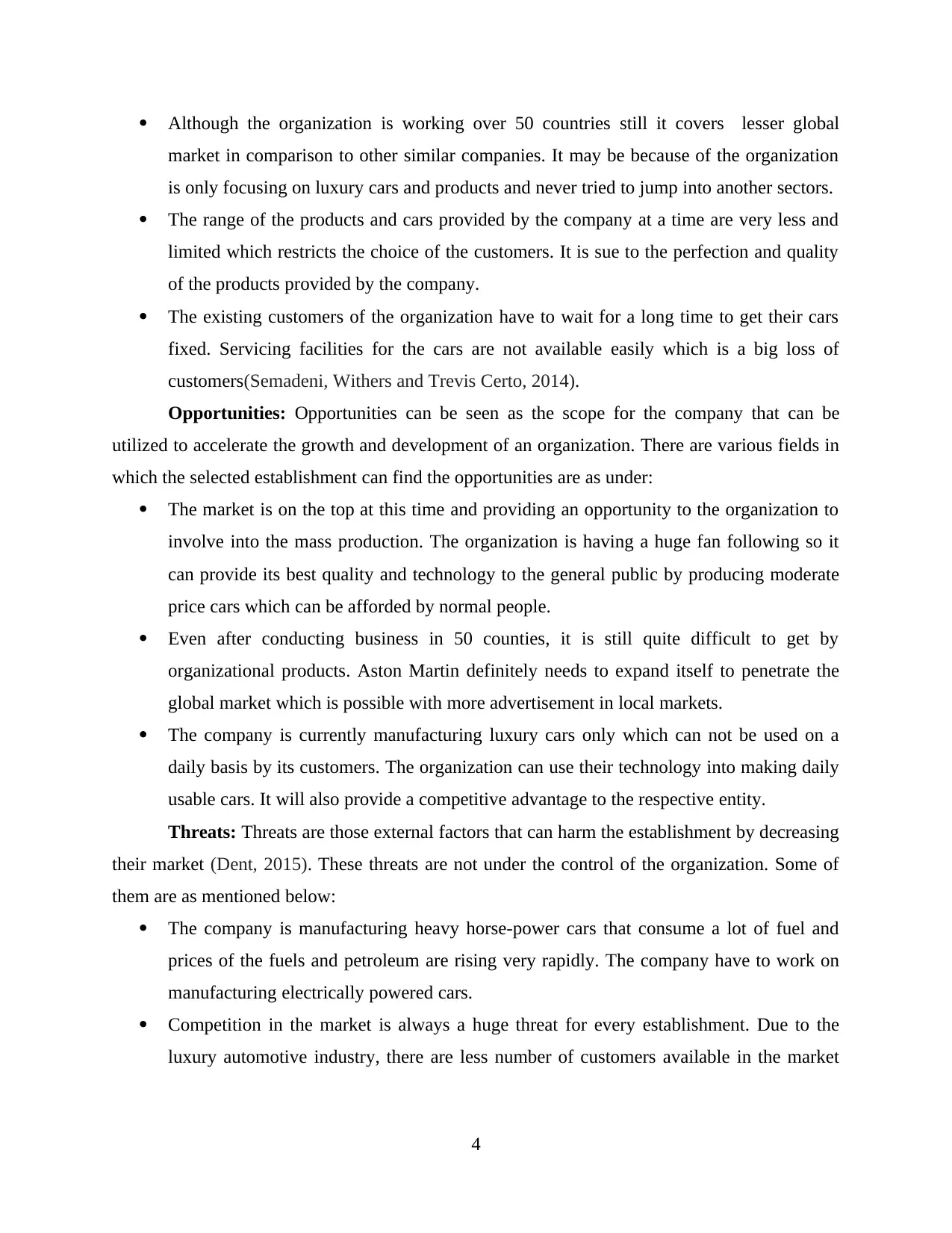
Although the organization is working over 50 countries still it covers lesser global
market in comparison to other similar companies. It may be because of the organization
is only focusing on luxury cars and products and never tried to jump into another sectors.
The range of the products and cars provided by the company at a time are very less and
limited which restricts the choice of the customers. It is sue to the perfection and quality
of the products provided by the company.
The existing customers of the organization have to wait for a long time to get their cars
fixed. Servicing facilities for the cars are not available easily which is a big loss of
customers(Semadeni, Withers and Trevis Certo, 2014).
Opportunities: Opportunities can be seen as the scope for the company that can be
utilized to accelerate the growth and development of an organization. There are various fields in
which the selected establishment can find the opportunities are as under:
The market is on the top at this time and providing an opportunity to the organization to
involve into the mass production. The organization is having a huge fan following so it
can provide its best quality and technology to the general public by producing moderate
price cars which can be afforded by normal people.
Even after conducting business in 50 counties, it is still quite difficult to get by
organizational products. Aston Martin definitely needs to expand itself to penetrate the
global market which is possible with more advertisement in local markets.
The company is currently manufacturing luxury cars only which can not be used on a
daily basis by its customers. The organization can use their technology into making daily
usable cars. It will also provide a competitive advantage to the respective entity.
Threats: Threats are those external factors that can harm the establishment by decreasing
their market (Dent, 2015). These threats are not under the control of the organization. Some of
them are as mentioned below:
The company is manufacturing heavy horse-power cars that consume a lot of fuel and
prices of the fuels and petroleum are rising very rapidly. The company have to work on
manufacturing electrically powered cars.
Competition in the market is always a huge threat for every establishment. Due to the
luxury automotive industry, there are less number of customers available in the market
4
market in comparison to other similar companies. It may be because of the organization
is only focusing on luxury cars and products and never tried to jump into another sectors.
The range of the products and cars provided by the company at a time are very less and
limited which restricts the choice of the customers. It is sue to the perfection and quality
of the products provided by the company.
The existing customers of the organization have to wait for a long time to get their cars
fixed. Servicing facilities for the cars are not available easily which is a big loss of
customers(Semadeni, Withers and Trevis Certo, 2014).
Opportunities: Opportunities can be seen as the scope for the company that can be
utilized to accelerate the growth and development of an organization. There are various fields in
which the selected establishment can find the opportunities are as under:
The market is on the top at this time and providing an opportunity to the organization to
involve into the mass production. The organization is having a huge fan following so it
can provide its best quality and technology to the general public by producing moderate
price cars which can be afforded by normal people.
Even after conducting business in 50 counties, it is still quite difficult to get by
organizational products. Aston Martin definitely needs to expand itself to penetrate the
global market which is possible with more advertisement in local markets.
The company is currently manufacturing luxury cars only which can not be used on a
daily basis by its customers. The organization can use their technology into making daily
usable cars. It will also provide a competitive advantage to the respective entity.
Threats: Threats are those external factors that can harm the establishment by decreasing
their market (Dent, 2015). These threats are not under the control of the organization. Some of
them are as mentioned below:
The company is manufacturing heavy horse-power cars that consume a lot of fuel and
prices of the fuels and petroleum are rising very rapidly. The company have to work on
manufacturing electrically powered cars.
Competition in the market is always a huge threat for every establishment. Due to the
luxury automotive industry, there are less number of customers available in the market
4
⊘ This is a preview!⊘
Do you want full access?
Subscribe today to unlock all pages.

Trusted by 1+ million students worldwide
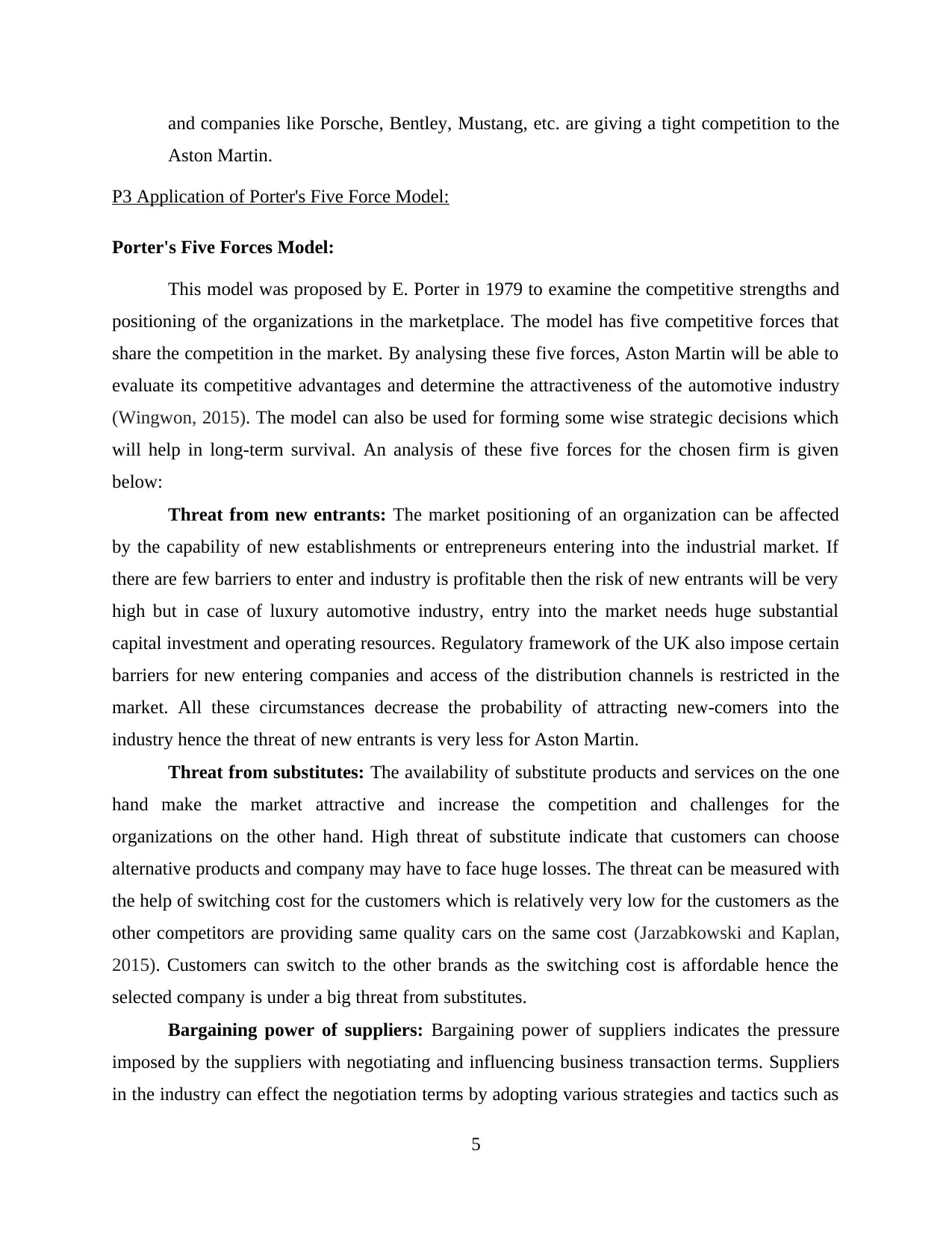
and companies like Porsche, Bentley, Mustang, etc. are giving a tight competition to the
Aston Martin.
P3 Application of Porter's Five Force Model:
Porter's Five Forces Model:
This model was proposed by E. Porter in 1979 to examine the competitive strengths and
positioning of the organizations in the marketplace. The model has five competitive forces that
share the competition in the market. By analysing these five forces, Aston Martin will be able to
evaluate its competitive advantages and determine the attractiveness of the automotive industry
(Wingwon, 2015). The model can also be used for forming some wise strategic decisions which
will help in long-term survival. An analysis of these five forces for the chosen firm is given
below:
Threat from new entrants: The market positioning of an organization can be affected
by the capability of new establishments or entrepreneurs entering into the industrial market. If
there are few barriers to enter and industry is profitable then the risk of new entrants will be very
high but in case of luxury automotive industry, entry into the market needs huge substantial
capital investment and operating resources. Regulatory framework of the UK also impose certain
barriers for new entering companies and access of the distribution channels is restricted in the
market. All these circumstances decrease the probability of attracting new-comers into the
industry hence the threat of new entrants is very less for Aston Martin.
Threat from substitutes: The availability of substitute products and services on the one
hand make the market attractive and increase the competition and challenges for the
organizations on the other hand. High threat of substitute indicate that customers can choose
alternative products and company may have to face huge losses. The threat can be measured with
the help of switching cost for the customers which is relatively very low for the customers as the
other competitors are providing same quality cars on the same cost (Jarzabkowski and Kaplan,
2015). Customers can switch to the other brands as the switching cost is affordable hence the
selected company is under a big threat from substitutes.
Bargaining power of suppliers: Bargaining power of suppliers indicates the pressure
imposed by the suppliers with negotiating and influencing business transaction terms. Suppliers
in the industry can effect the negotiation terms by adopting various strategies and tactics such as
5
Aston Martin.
P3 Application of Porter's Five Force Model:
Porter's Five Forces Model:
This model was proposed by E. Porter in 1979 to examine the competitive strengths and
positioning of the organizations in the marketplace. The model has five competitive forces that
share the competition in the market. By analysing these five forces, Aston Martin will be able to
evaluate its competitive advantages and determine the attractiveness of the automotive industry
(Wingwon, 2015). The model can also be used for forming some wise strategic decisions which
will help in long-term survival. An analysis of these five forces for the chosen firm is given
below:
Threat from new entrants: The market positioning of an organization can be affected
by the capability of new establishments or entrepreneurs entering into the industrial market. If
there are few barriers to enter and industry is profitable then the risk of new entrants will be very
high but in case of luxury automotive industry, entry into the market needs huge substantial
capital investment and operating resources. Regulatory framework of the UK also impose certain
barriers for new entering companies and access of the distribution channels is restricted in the
market. All these circumstances decrease the probability of attracting new-comers into the
industry hence the threat of new entrants is very less for Aston Martin.
Threat from substitutes: The availability of substitute products and services on the one
hand make the market attractive and increase the competition and challenges for the
organizations on the other hand. High threat of substitute indicate that customers can choose
alternative products and company may have to face huge losses. The threat can be measured with
the help of switching cost for the customers which is relatively very low for the customers as the
other competitors are providing same quality cars on the same cost (Jarzabkowski and Kaplan,
2015). Customers can switch to the other brands as the switching cost is affordable hence the
selected company is under a big threat from substitutes.
Bargaining power of suppliers: Bargaining power of suppliers indicates the pressure
imposed by the suppliers with negotiating and influencing business transaction terms. Suppliers
in the industry can effect the negotiation terms by adopting various strategies and tactics such as
5
Paraphrase This Document
Need a fresh take? Get an instant paraphrase of this document with our AI Paraphraser
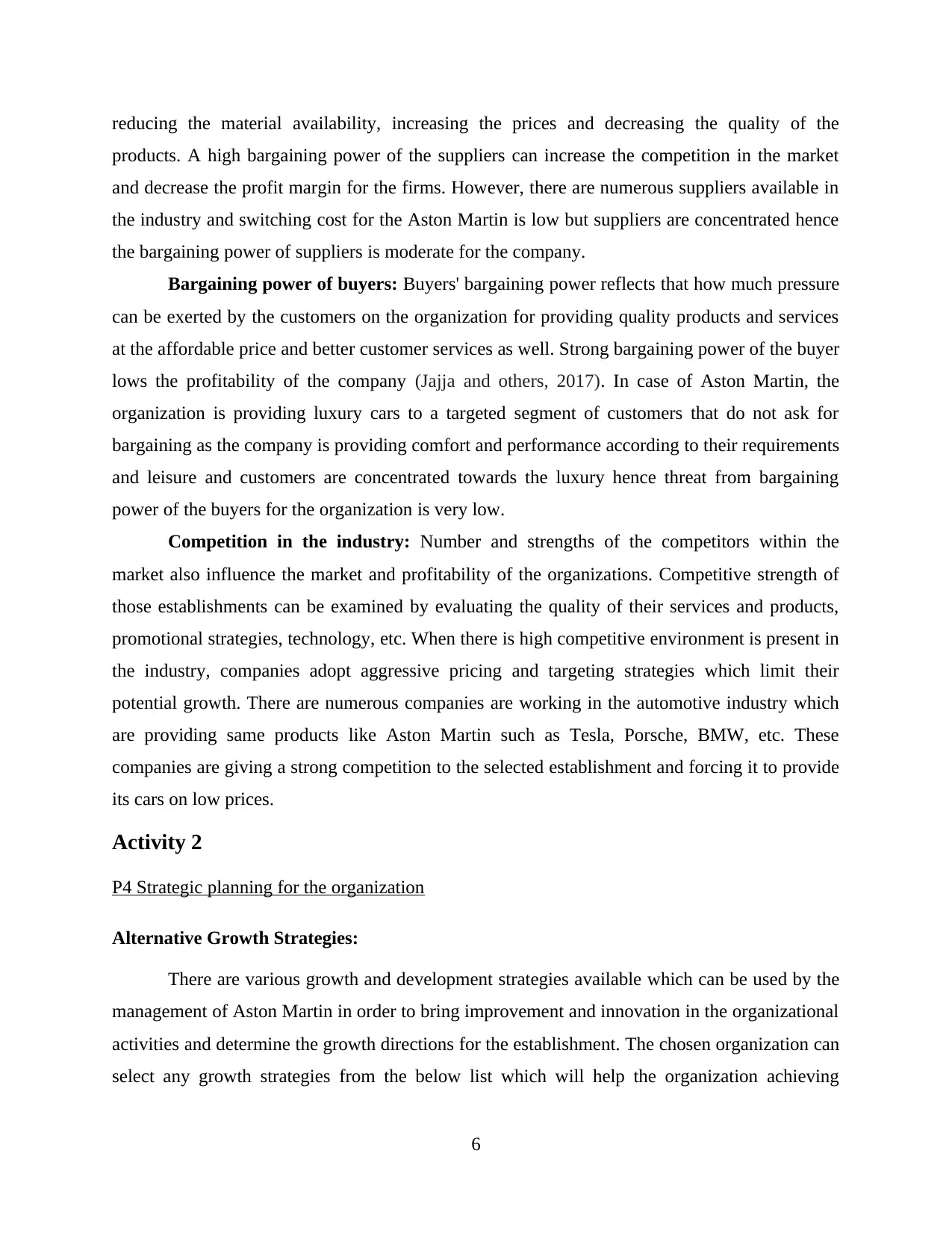
reducing the material availability, increasing the prices and decreasing the quality of the
products. A high bargaining power of the suppliers can increase the competition in the market
and decrease the profit margin for the firms. However, there are numerous suppliers available in
the industry and switching cost for the Aston Martin is low but suppliers are concentrated hence
the bargaining power of suppliers is moderate for the company.
Bargaining power of buyers: Buyers' bargaining power reflects that how much pressure
can be exerted by the customers on the organization for providing quality products and services
at the affordable price and better customer services as well. Strong bargaining power of the buyer
lows the profitability of the company (Jajja and others, 2017). In case of Aston Martin, the
organization is providing luxury cars to a targeted segment of customers that do not ask for
bargaining as the company is providing comfort and performance according to their requirements
and leisure and customers are concentrated towards the luxury hence threat from bargaining
power of the buyers for the organization is very low.
Competition in the industry: Number and strengths of the competitors within the
market also influence the market and profitability of the organizations. Competitive strength of
those establishments can be examined by evaluating the quality of their services and products,
promotional strategies, technology, etc. When there is high competitive environment is present in
the industry, companies adopt aggressive pricing and targeting strategies which limit their
potential growth. There are numerous companies are working in the automotive industry which
are providing same products like Aston Martin such as Tesla, Porsche, BMW, etc. These
companies are giving a strong competition to the selected establishment and forcing it to provide
its cars on low prices.
Activity 2
P4 Strategic planning for the organization
Alternative Growth Strategies:
There are various growth and development strategies available which can be used by the
management of Aston Martin in order to bring improvement and innovation in the organizational
activities and determine the growth directions for the establishment. The chosen organization can
select any growth strategies from the below list which will help the organization achieving
6
products. A high bargaining power of the suppliers can increase the competition in the market
and decrease the profit margin for the firms. However, there are numerous suppliers available in
the industry and switching cost for the Aston Martin is low but suppliers are concentrated hence
the bargaining power of suppliers is moderate for the company.
Bargaining power of buyers: Buyers' bargaining power reflects that how much pressure
can be exerted by the customers on the organization for providing quality products and services
at the affordable price and better customer services as well. Strong bargaining power of the buyer
lows the profitability of the company (Jajja and others, 2017). In case of Aston Martin, the
organization is providing luxury cars to a targeted segment of customers that do not ask for
bargaining as the company is providing comfort and performance according to their requirements
and leisure and customers are concentrated towards the luxury hence threat from bargaining
power of the buyers for the organization is very low.
Competition in the industry: Number and strengths of the competitors within the
market also influence the market and profitability of the organizations. Competitive strength of
those establishments can be examined by evaluating the quality of their services and products,
promotional strategies, technology, etc. When there is high competitive environment is present in
the industry, companies adopt aggressive pricing and targeting strategies which limit their
potential growth. There are numerous companies are working in the automotive industry which
are providing same products like Aston Martin such as Tesla, Porsche, BMW, etc. These
companies are giving a strong competition to the selected establishment and forcing it to provide
its cars on low prices.
Activity 2
P4 Strategic planning for the organization
Alternative Growth Strategies:
There are various growth and development strategies available which can be used by the
management of Aston Martin in order to bring improvement and innovation in the organizational
activities and determine the growth directions for the establishment. The chosen organization can
select any growth strategies from the below list which will help the organization achieving
6
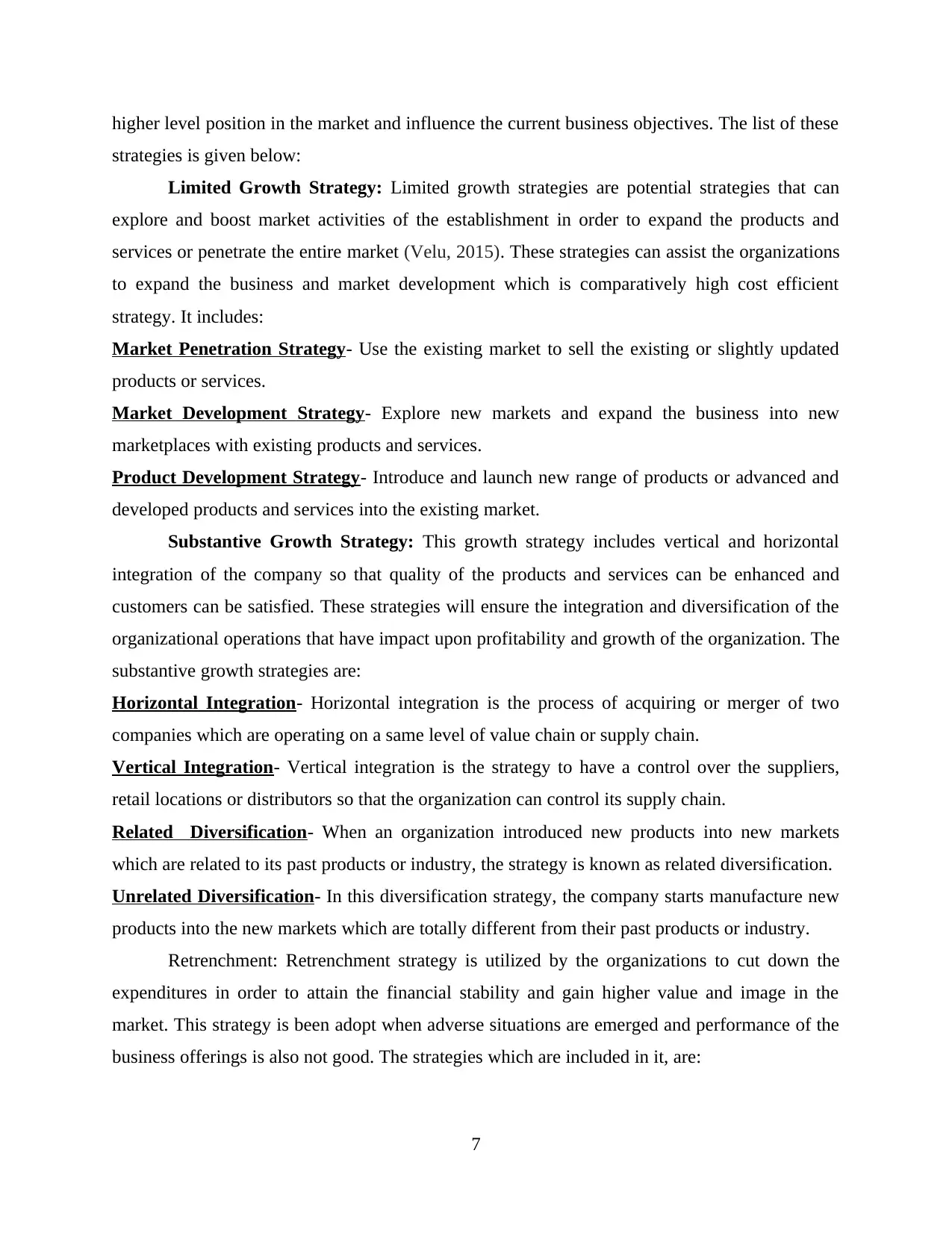
higher level position in the market and influence the current business objectives. The list of these
strategies is given below:
Limited Growth Strategy: Limited growth strategies are potential strategies that can
explore and boost market activities of the establishment in order to expand the products and
services or penetrate the entire market (Velu, 2015). These strategies can assist the organizations
to expand the business and market development which is comparatively high cost efficient
strategy. It includes:
Market Penetration Strategy- Use the existing market to sell the existing or slightly updated
products or services.
Market Development Strategy- Explore new markets and expand the business into new
marketplaces with existing products and services.
Product Development Strategy- Introduce and launch new range of products or advanced and
developed products and services into the existing market.
Substantive Growth Strategy: This growth strategy includes vertical and horizontal
integration of the company so that quality of the products and services can be enhanced and
customers can be satisfied. These strategies will ensure the integration and diversification of the
organizational operations that have impact upon profitability and growth of the organization. The
substantive growth strategies are:
Horizontal Integration- Horizontal integration is the process of acquiring or merger of two
companies which are operating on a same level of value chain or supply chain.
Vertical Integration- Vertical integration is the strategy to have a control over the suppliers,
retail locations or distributors so that the organization can control its supply chain.
Related Diversification- When an organization introduced new products into new markets
which are related to its past products or industry, the strategy is known as related diversification.
Unrelated Diversification- In this diversification strategy, the company starts manufacture new
products into the new markets which are totally different from their past products or industry.
Retrenchment: Retrenchment strategy is utilized by the organizations to cut down the
expenditures in order to attain the financial stability and gain higher value and image in the
market. This strategy is been adopt when adverse situations are emerged and performance of the
business offerings is also not good. The strategies which are included in it, are:
7
strategies is given below:
Limited Growth Strategy: Limited growth strategies are potential strategies that can
explore and boost market activities of the establishment in order to expand the products and
services or penetrate the entire market (Velu, 2015). These strategies can assist the organizations
to expand the business and market development which is comparatively high cost efficient
strategy. It includes:
Market Penetration Strategy- Use the existing market to sell the existing or slightly updated
products or services.
Market Development Strategy- Explore new markets and expand the business into new
marketplaces with existing products and services.
Product Development Strategy- Introduce and launch new range of products or advanced and
developed products and services into the existing market.
Substantive Growth Strategy: This growth strategy includes vertical and horizontal
integration of the company so that quality of the products and services can be enhanced and
customers can be satisfied. These strategies will ensure the integration and diversification of the
organizational operations that have impact upon profitability and growth of the organization. The
substantive growth strategies are:
Horizontal Integration- Horizontal integration is the process of acquiring or merger of two
companies which are operating on a same level of value chain or supply chain.
Vertical Integration- Vertical integration is the strategy to have a control over the suppliers,
retail locations or distributors so that the organization can control its supply chain.
Related Diversification- When an organization introduced new products into new markets
which are related to its past products or industry, the strategy is known as related diversification.
Unrelated Diversification- In this diversification strategy, the company starts manufacture new
products into the new markets which are totally different from their past products or industry.
Retrenchment: Retrenchment strategy is utilized by the organizations to cut down the
expenditures in order to attain the financial stability and gain higher value and image in the
market. This strategy is been adopt when adverse situations are emerged and performance of the
business offerings is also not good. The strategies which are included in it, are:
7
⊘ This is a preview!⊘
Do you want full access?
Subscribe today to unlock all pages.

Trusted by 1+ million students worldwide
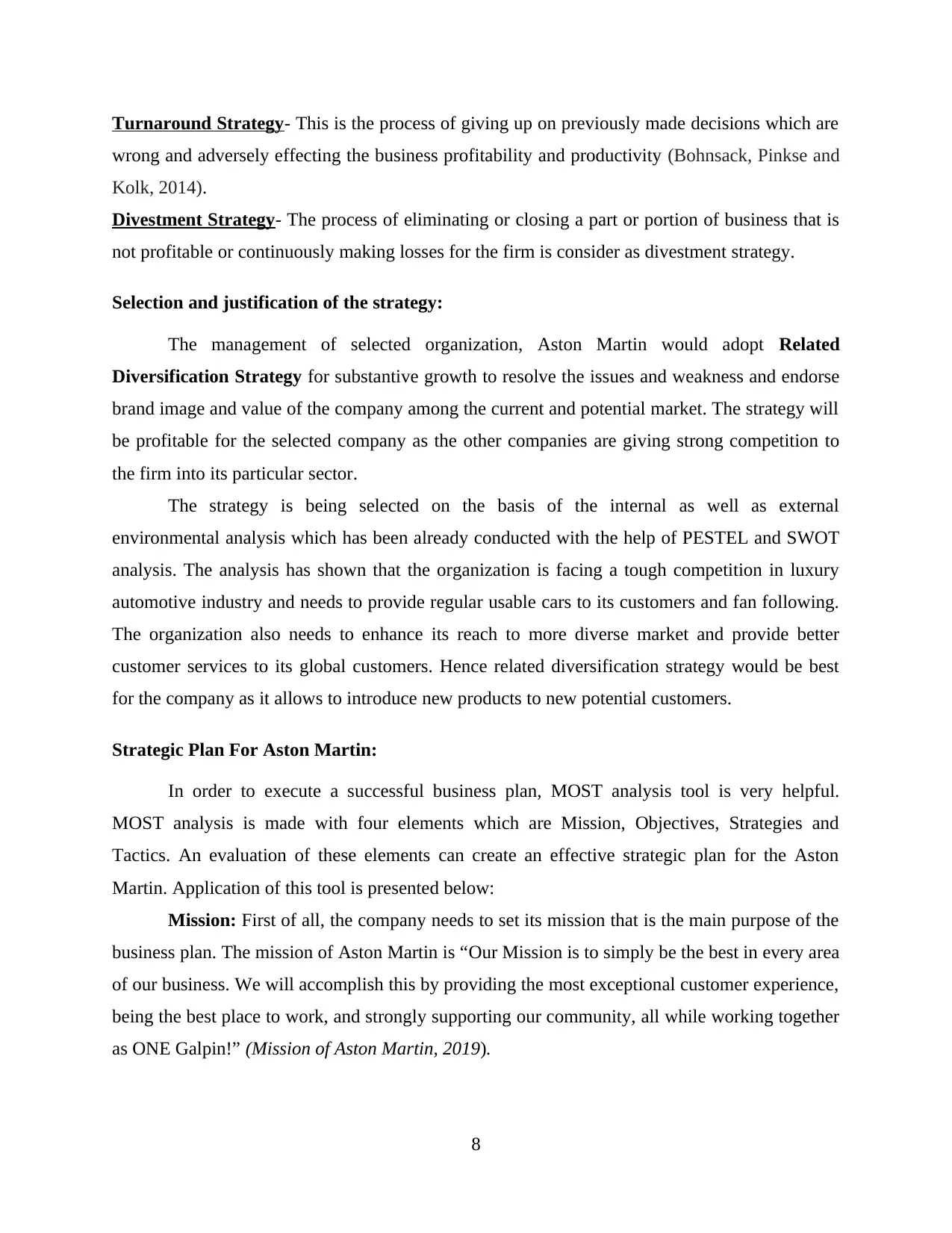
Turnaround Strategy- This is the process of giving up on previously made decisions which are
wrong and adversely effecting the business profitability and productivity (Bohnsack, Pinkse and
Kolk, 2014).
Divestment Strategy- The process of eliminating or closing a part or portion of business that is
not profitable or continuously making losses for the firm is consider as divestment strategy.
Selection and justification of the strategy:
The management of selected organization, Aston Martin would adopt Related
Diversification Strategy for substantive growth to resolve the issues and weakness and endorse
brand image and value of the company among the current and potential market. The strategy will
be profitable for the selected company as the other companies are giving strong competition to
the firm into its particular sector.
The strategy is being selected on the basis of the internal as well as external
environmental analysis which has been already conducted with the help of PESTEL and SWOT
analysis. The analysis has shown that the organization is facing a tough competition in luxury
automotive industry and needs to provide regular usable cars to its customers and fan following.
The organization also needs to enhance its reach to more diverse market and provide better
customer services to its global customers. Hence related diversification strategy would be best
for the company as it allows to introduce new products to new potential customers.
Strategic Plan For Aston Martin:
In order to execute a successful business plan, MOST analysis tool is very helpful.
MOST analysis is made with four elements which are Mission, Objectives, Strategies and
Tactics. An evaluation of these elements can create an effective strategic plan for the Aston
Martin. Application of this tool is presented below:
Mission: First of all, the company needs to set its mission that is the main purpose of the
business plan. The mission of Aston Martin is “Our Mission is to simply be the best in every area
of our business. We will accomplish this by providing the most exceptional customer experience,
being the best place to work, and strongly supporting our community, all while working together
as ONE Galpin!” (Mission of Aston Martin, 2019).
8
wrong and adversely effecting the business profitability and productivity (Bohnsack, Pinkse and
Kolk, 2014).
Divestment Strategy- The process of eliminating or closing a part or portion of business that is
not profitable or continuously making losses for the firm is consider as divestment strategy.
Selection and justification of the strategy:
The management of selected organization, Aston Martin would adopt Related
Diversification Strategy for substantive growth to resolve the issues and weakness and endorse
brand image and value of the company among the current and potential market. The strategy will
be profitable for the selected company as the other companies are giving strong competition to
the firm into its particular sector.
The strategy is being selected on the basis of the internal as well as external
environmental analysis which has been already conducted with the help of PESTEL and SWOT
analysis. The analysis has shown that the organization is facing a tough competition in luxury
automotive industry and needs to provide regular usable cars to its customers and fan following.
The organization also needs to enhance its reach to more diverse market and provide better
customer services to its global customers. Hence related diversification strategy would be best
for the company as it allows to introduce new products to new potential customers.
Strategic Plan For Aston Martin:
In order to execute a successful business plan, MOST analysis tool is very helpful.
MOST analysis is made with four elements which are Mission, Objectives, Strategies and
Tactics. An evaluation of these elements can create an effective strategic plan for the Aston
Martin. Application of this tool is presented below:
Mission: First of all, the company needs to set its mission that is the main purpose of the
business plan. The mission of Aston Martin is “Our Mission is to simply be the best in every area
of our business. We will accomplish this by providing the most exceptional customer experience,
being the best place to work, and strongly supporting our community, all while working together
as ONE Galpin!” (Mission of Aston Martin, 2019).
8
Paraphrase This Document
Need a fresh take? Get an instant paraphrase of this document with our AI Paraphraser
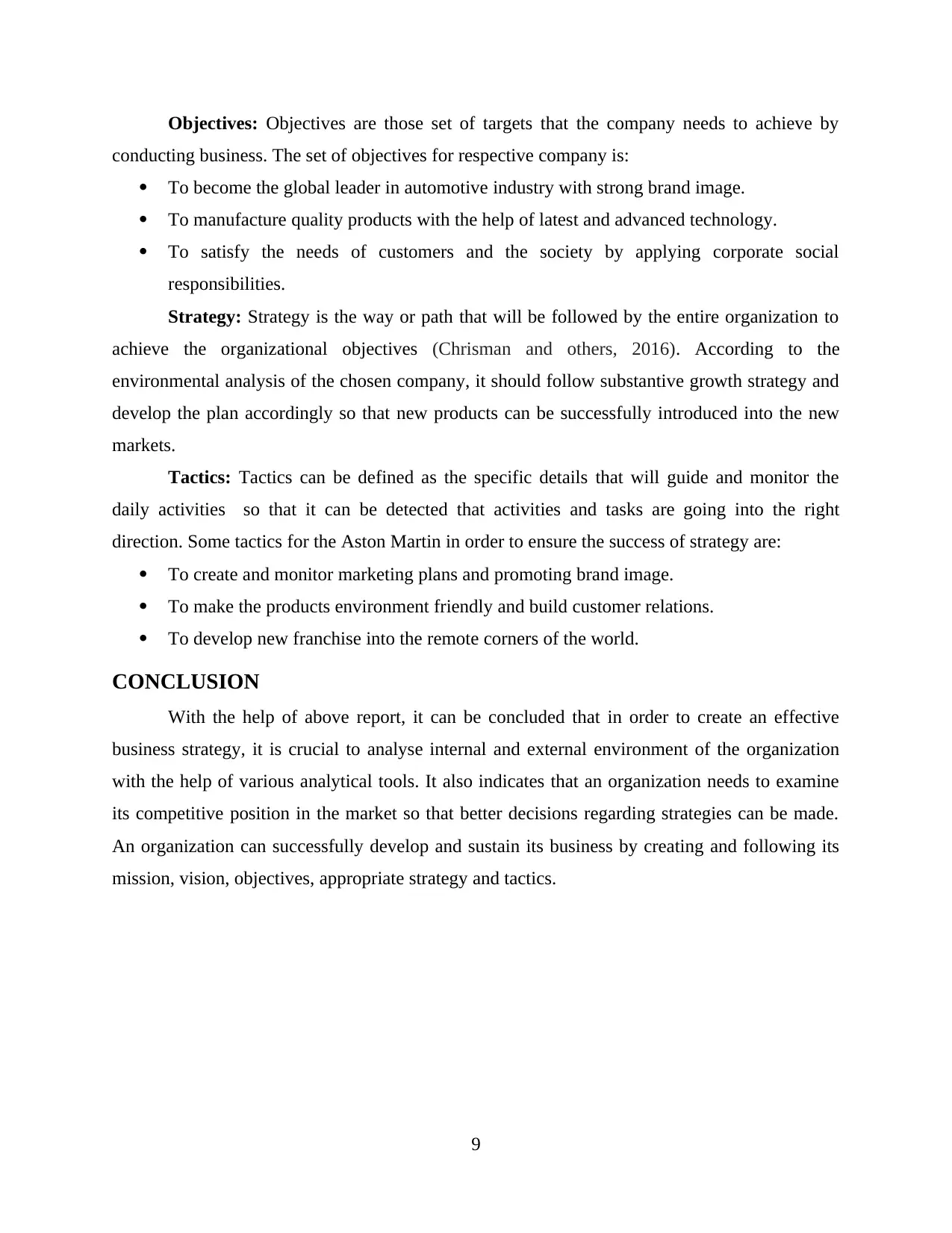
Objectives: Objectives are those set of targets that the company needs to achieve by
conducting business. The set of objectives for respective company is:
To become the global leader in automotive industry with strong brand image.
To manufacture quality products with the help of latest and advanced technology.
To satisfy the needs of customers and the society by applying corporate social
responsibilities.
Strategy: Strategy is the way or path that will be followed by the entire organization to
achieve the organizational objectives (Chrisman and others, 2016). According to the
environmental analysis of the chosen company, it should follow substantive growth strategy and
develop the plan accordingly so that new products can be successfully introduced into the new
markets.
Tactics: Tactics can be defined as the specific details that will guide and monitor the
daily activities so that it can be detected that activities and tasks are going into the right
direction. Some tactics for the Aston Martin in order to ensure the success of strategy are:
To create and monitor marketing plans and promoting brand image.
To make the products environment friendly and build customer relations.
To develop new franchise into the remote corners of the world.
CONCLUSION
With the help of above report, it can be concluded that in order to create an effective
business strategy, it is crucial to analyse internal and external environment of the organization
with the help of various analytical tools. It also indicates that an organization needs to examine
its competitive position in the market so that better decisions regarding strategies can be made.
An organization can successfully develop and sustain its business by creating and following its
mission, vision, objectives, appropriate strategy and tactics.
9
conducting business. The set of objectives for respective company is:
To become the global leader in automotive industry with strong brand image.
To manufacture quality products with the help of latest and advanced technology.
To satisfy the needs of customers and the society by applying corporate social
responsibilities.
Strategy: Strategy is the way or path that will be followed by the entire organization to
achieve the organizational objectives (Chrisman and others, 2016). According to the
environmental analysis of the chosen company, it should follow substantive growth strategy and
develop the plan accordingly so that new products can be successfully introduced into the new
markets.
Tactics: Tactics can be defined as the specific details that will guide and monitor the
daily activities so that it can be detected that activities and tasks are going into the right
direction. Some tactics for the Aston Martin in order to ensure the success of strategy are:
To create and monitor marketing plans and promoting brand image.
To make the products environment friendly and build customer relations.
To develop new franchise into the remote corners of the world.
CONCLUSION
With the help of above report, it can be concluded that in order to create an effective
business strategy, it is crucial to analyse internal and external environment of the organization
with the help of various analytical tools. It also indicates that an organization needs to examine
its competitive position in the market so that better decisions regarding strategies can be made.
An organization can successfully develop and sustain its business by creating and following its
mission, vision, objectives, appropriate strategy and tactics.
9
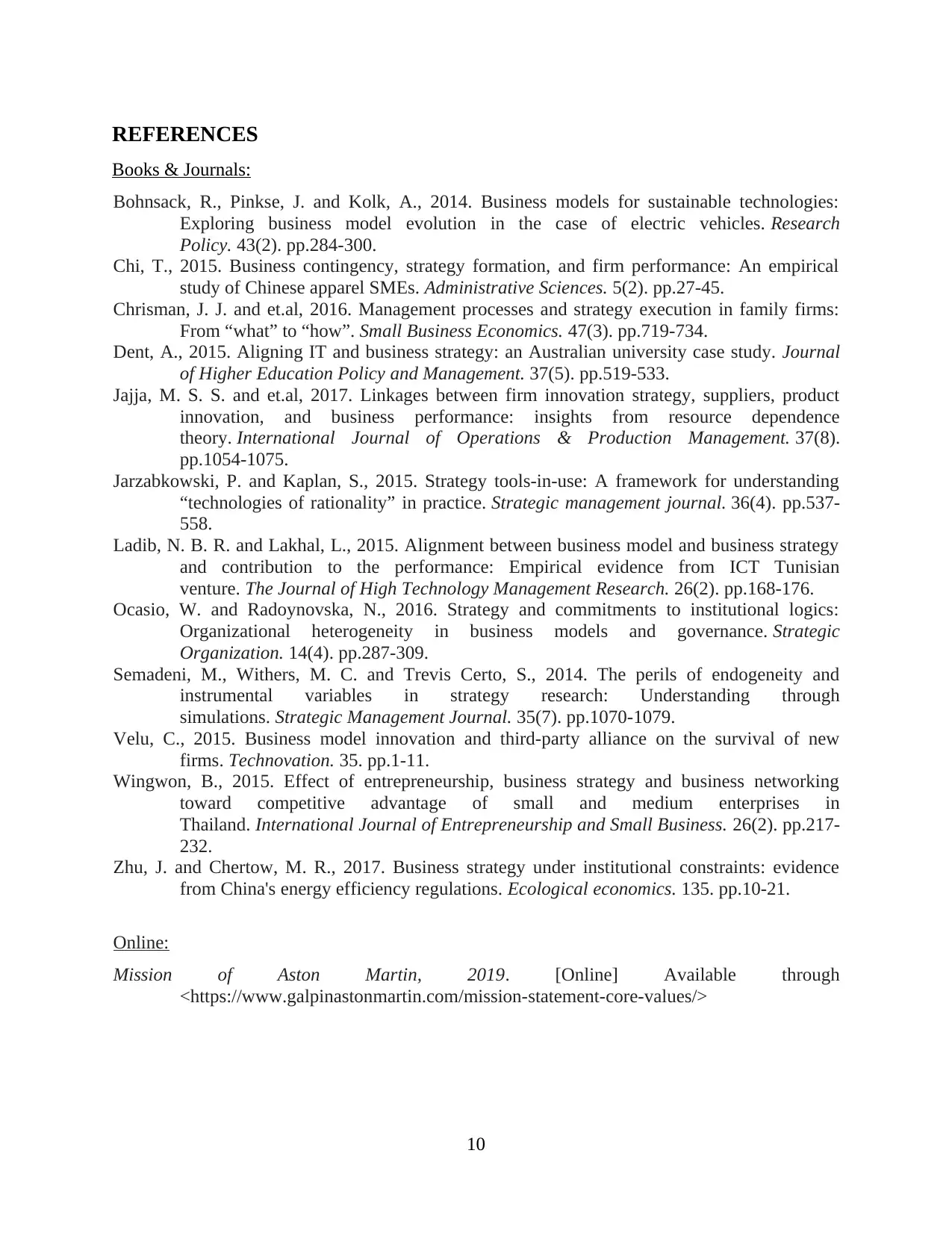
REFERENCES
Books & Journals:
Bohnsack, R., Pinkse, J. and Kolk, A., 2014. Business models for sustainable technologies:
Exploring business model evolution in the case of electric vehicles. Research
Policy. 43(2). pp.284-300.
Chi, T., 2015. Business contingency, strategy formation, and firm performance: An empirical
study of Chinese apparel SMEs. Administrative Sciences. 5(2). pp.27-45.
Chrisman, J. J. and et.al, 2016. Management processes and strategy execution in family firms:
From “what” to “how”. Small Business Economics. 47(3). pp.719-734.
Dent, A., 2015. Aligning IT and business strategy: an Australian university case study. Journal
of Higher Education Policy and Management. 37(5). pp.519-533.
Jajja, M. S. S. and et.al, 2017. Linkages between firm innovation strategy, suppliers, product
innovation, and business performance: insights from resource dependence
theory. International Journal of Operations & Production Management. 37(8).
pp.1054-1075.
Jarzabkowski, P. and Kaplan, S., 2015. Strategy tools‐in‐use: A framework for understanding
“technologies of rationality” in practice. Strategic management journal. 36(4). pp.537-
558.
Ladib, N. B. R. and Lakhal, L., 2015. Alignment between business model and business strategy
and contribution to the performance: Empirical evidence from ICT Tunisian
venture. The Journal of High Technology Management Research. 26(2). pp.168-176.
Ocasio, W. and Radoynovska, N., 2016. Strategy and commitments to institutional logics:
Organizational heterogeneity in business models and governance. Strategic
Organization. 14(4). pp.287-309.
Semadeni, M., Withers, M. C. and Trevis Certo, S., 2014. The perils of endogeneity and
instrumental variables in strategy research: Understanding through
simulations. Strategic Management Journal. 35(7). pp.1070-1079.
Velu, C., 2015. Business model innovation and third-party alliance on the survival of new
firms. Technovation. 35. pp.1-11.
Wingwon, B., 2015. Effect of entrepreneurship, business strategy and business networking
toward competitive advantage of small and medium enterprises in
Thailand. International Journal of Entrepreneurship and Small Business. 26(2). pp.217-
232.
Zhu, J. and Chertow, M. R., 2017. Business strategy under institutional constraints: evidence
from China's energy efficiency regulations. Ecological economics. 135. pp.10-21.
Online:
Mission of Aston Martin, 2019. [Online] Available through
<https://www.galpinastonmartin.com/mission-statement-core-values/>
10
Books & Journals:
Bohnsack, R., Pinkse, J. and Kolk, A., 2014. Business models for sustainable technologies:
Exploring business model evolution in the case of electric vehicles. Research
Policy. 43(2). pp.284-300.
Chi, T., 2015. Business contingency, strategy formation, and firm performance: An empirical
study of Chinese apparel SMEs. Administrative Sciences. 5(2). pp.27-45.
Chrisman, J. J. and et.al, 2016. Management processes and strategy execution in family firms:
From “what” to “how”. Small Business Economics. 47(3). pp.719-734.
Dent, A., 2015. Aligning IT and business strategy: an Australian university case study. Journal
of Higher Education Policy and Management. 37(5). pp.519-533.
Jajja, M. S. S. and et.al, 2017. Linkages between firm innovation strategy, suppliers, product
innovation, and business performance: insights from resource dependence
theory. International Journal of Operations & Production Management. 37(8).
pp.1054-1075.
Jarzabkowski, P. and Kaplan, S., 2015. Strategy tools‐in‐use: A framework for understanding
“technologies of rationality” in practice. Strategic management journal. 36(4). pp.537-
558.
Ladib, N. B. R. and Lakhal, L., 2015. Alignment between business model and business strategy
and contribution to the performance: Empirical evidence from ICT Tunisian
venture. The Journal of High Technology Management Research. 26(2). pp.168-176.
Ocasio, W. and Radoynovska, N., 2016. Strategy and commitments to institutional logics:
Organizational heterogeneity in business models and governance. Strategic
Organization. 14(4). pp.287-309.
Semadeni, M., Withers, M. C. and Trevis Certo, S., 2014. The perils of endogeneity and
instrumental variables in strategy research: Understanding through
simulations. Strategic Management Journal. 35(7). pp.1070-1079.
Velu, C., 2015. Business model innovation and third-party alliance on the survival of new
firms. Technovation. 35. pp.1-11.
Wingwon, B., 2015. Effect of entrepreneurship, business strategy and business networking
toward competitive advantage of small and medium enterprises in
Thailand. International Journal of Entrepreneurship and Small Business. 26(2). pp.217-
232.
Zhu, J. and Chertow, M. R., 2017. Business strategy under institutional constraints: evidence
from China's energy efficiency regulations. Ecological economics. 135. pp.10-21.
Online:
Mission of Aston Martin, 2019. [Online] Available through
<https://www.galpinastonmartin.com/mission-statement-core-values/>
10
⊘ This is a preview!⊘
Do you want full access?
Subscribe today to unlock all pages.

Trusted by 1+ million students worldwide
1 out of 12
Related Documents
Your All-in-One AI-Powered Toolkit for Academic Success.
+13062052269
info@desklib.com
Available 24*7 on WhatsApp / Email
![[object Object]](/_next/static/media/star-bottom.7253800d.svg)
Unlock your academic potential
Copyright © 2020–2025 A2Z Services. All Rights Reserved. Developed and managed by ZUCOL.





